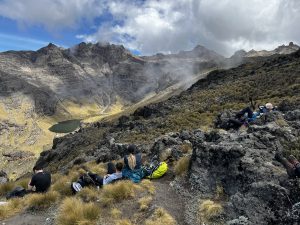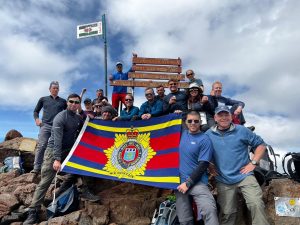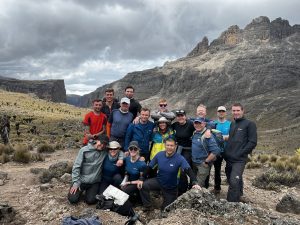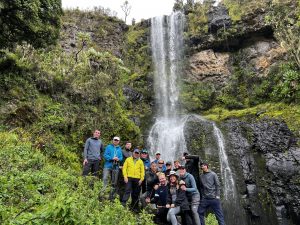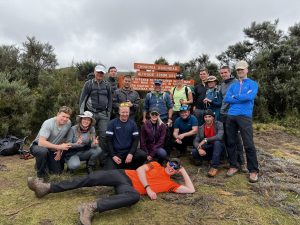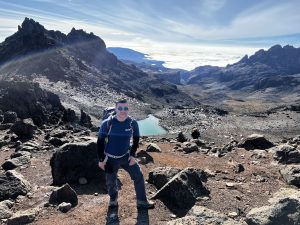Sir Edmund Hillary, the first mountaineer to summit Mount Everest stated, “People do not decide to become extraordinary. They decide to accomplish extraordinary things.” Hillary understood that life challenges provide opportunities to achieve personal growth and development. In July 2022, sixteen committed army reservists from 156 Regiment RLC achieved a remarkable goal and summited Point Lenana (4985m), Mount Kenya. This arduous, adventurous training expedition offered soldiers a fantastic opportunity to develop personal attributes and skills through controlled exposure to risk.
The mission was to climb Mount Kenya via the Chogoria and Sirimon Routes to Point Lenana (4985m) the third highest (non-technical) summit. At 5199m, Mount Kenya is Africa’s second highest mountain after Kilimanjaro. This ancient, extinct volcano which rises in the centre of the country is usually capped with ice and snow and forests blanket its slopes. The local African communities who live under it regard Mount Kenya as sacred and God’s earthly home. Point Lenana is the third highest summit in the massif and is shadowed by Batian at an intimidating 5199m and Nelion at 5188m. A BATUK-approved, civilian adventurous training company, African Ascents Ltd, provided support for the expedition.
The expedition was considered High Risk and Remote (HRR) and was conducted at high altitude (between 2500 -3500m above sea level) and very high-altitude (over 3500m). Preparatory UK-based training activities were essential in order to mitigate climatic and environmental risks during the expedition. Soldiers were required to complete two training weekends, one in Snowdonia National Park in the vicinity of Cnicht mountain and the other in the Lake District National Park over Bowfell and Crinkle Crags. During the two weekends, soldiers not only improved their hill waking and navigational skills but also developed their physical fitness in an effort to ensure they were sufficiently prepared to take part in the challenging expedition. The training activities were instrumental in fostering authentic bonds and building trust between expedition members.
The journey to Kenya was particularly disastrous but there is nothing more forgettable than a journey which goes according to plan! After 36 hours of travel which involved a missed connection flight in Doha airport, a six-hour nap on a hard airport floor, a surprise journey to Saudi Arabia, a stolen wallet and two lost hold bags, the group finally landed at Jomo Kenyatta International Airport in Nairobi. A short commute by coach transport through the bustling Nairobi streets, past honking Matutas (privately owned disco buses), took the group to Kifaru Barracks Nairobi and a long-awaited, comfortable bed. An early morning start saw the group travel some four hours to Nyati Barracks Nanyuki, where soldiers completed elements of the Summer Mountain Foundation syllabus prior to embarking on the expedition.
Following initial acclimatisation, the group were collected outside Nyati Barracks by Paul and Bonnie, the guides from African Ascents Ltd. The minibus journey to the start of the Chogoria Route consisted of a steep climb up a dirt track through the montane wetland forests. The minibus spluttered, shimmied and slid across the bright, red mud until its back tyres became hopelessly stuck. Even with the help of sixteen soldiers, each attempt to dislodge the vehicle seemed to bury the tyres deeper into the mud until a Land Rover came to save the day. Maj Dowling’s expert rope tying skills enabled the minibus to be towed to safety and the group eventually arrived at the Chogoria Gate (2950m), to start the expedition.
It was a blue-sky day as everyone departed from the Chogoria Gate along arguably the most magnificent ascent to the summit. A walk through the cloud forest above the condensation level brought the group to the first campsite, which the porters had painstakingly prepared by erecting seven tents and one mess tent. After a generous evening meal comprising of tomato soup and hearty chicken stew, everyone retired to their tents for an early night’s sleep.
Day two saw the group hike past the natural tree line, across drought-resistant plant communities to Chogoria Roadhead at 3300m. A trek down a steep slope brought everyone to Nithi Falls, a majestic waterfall which surges and plunges down the eastern slopes of Mount Kenya. The hike progressed through extensive moorland on humid slopes past cushion plants and heath grasses to the breathtakingly beautiful Lake Ellis. Located at 3455m, Lake Ellis is the third largest lake on Mount Kenya. An adventurous few bravely swam in the lake and greatly under-estimated how cold the water was!
The team left the shores of Lake Ellis early in the morning on day three and were faced with the longest trek of the expedition. After a rather strenuous walk, the Gorges Valley eventually came into view. As the mist blanketing the valley started to clear, the magnificent, glassy waters of Lake Michaelson could be seen surrounded by imposing red cliffs. The group descended down a steep, treacherous path to Lake Michaelson in order to allow for recuperation at a lower altitude overnight.
The next morning, the group were welcomed by several hyraxes (large guinea-pig-like creatures) which could be seen scrambling around the rock face near camp. As everyone ascended towards Simba Col Camp (4620m) and the altitude increased, the flora and fauna became more specialised and giant Lobelias could be seen with thick stems and large, impressive flower heads. At the end of day four, at Simba Col Camp, the temperature dropped below freezing and sleep became difficult for everyone.
On the morning of day five, the group started their ascent to the summit. The hike took everyone over a moon-like landscape uninhabitable for flora and fauna with jagged rock and ice. The group finally summited Point Lenana around midday after a precipitous, rocky climb. The sense of achievement everyone felt at accomplishing such a fulfilling goal won’t be something that is easily forgotten. After taking endless photographs in an attempt to capture the beauty of the mountain, the group started their long, challenging descent towards Old Moses Camp.
Day six saw everyone walk down the southern side of Mount Kenya along the Sirimon Route towards the collection point at Old Moses Camp. With tired legs, everyone clambered into the minibus and said their farewells to a wonderful team of porters and guides who had made their dream a reality.
Completion of the Mount Kenya expedition was a once-in-a-lifetime opportunity for me. It’s what I joined the Army Reserve to do, to challenge myself and get outside of my comfort zone. I got to spend the time with a great bunch of people and it’s inspired me travel more and explore new places.
Pte Ryan Culshaw, 238 (Sefton) Squadron, 156 Regiment RLC
On returning to BATUK, soldiers were able to decompress over two days which involved a trip to Ngare Ndare Forest, a protected, hidden treasure in the foothills of Mount Kenya. Pristine blue pools and waterfalls awaited everyone, followed by a walk across a long suspended bridge above the tree canopy.
Having climbed more than four times the height of Snowdon (1085m) in five days, everyone was genuinely proud of their achievement. This expedition presented soldiers with a unique opportunity to stretch their capabilities and gain a greater understanding of the skills required in the mountain environment. In the words of Sir Edmund Hillary, “It is not the mountain we conquer, but ourselves.” In the face of adversity and when unforeseen obstacles presented themselves, all soldiers approached the expedition with a stoic mindset and were not defeated by the scale of the task at hand. During this testing climb, and working together as a team, all participants attained Summer Mountain Foundation qualifications which some hope to use in the future to attain the MLT qualification.
As with previous overseas expeditions organised by 156 Regiment RLC, the monetary grant provided by the Ulysses Trust made a significant difference to the overall finances. This generous support reduced personal contributions for all team members and made it affordable for everyone. On behalf of all participants, our sincere thanks and appreciation to the Ulysses Trust for helping to enable this expedition.

